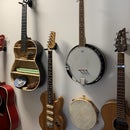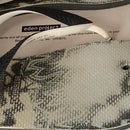Introduction: Ticket to Ride New Zealand Boardgame
Kia ora and welcome,
This is a project in progress, but all the files are available for download and trial. Print it off, give it a go and let me know if there should be any changes.
The original game concept is Ticket to Ride and there is likely a similar version for your own country. There are fan designs here and here. I've printed Germany and it's pretty fun. If not, use my files to make one. The great thing is that Days of Wonder are pretty happy for people to make fan versions and have the links on their own website. As it turns out, there are a heap of resources and files at BoardGameGeek that I didn't know existed when I made this game. I imagine that there are more files, maps and resources that can help you create your own. People have made all kinds of fun maps including Springfield, the Isle of Sodor, Middle Earth, the Moon, Space, various other languages and pocket travel versions of the game. Let's just say humans like this game a lot.
My version adds a few twists and changes the language of trains to the language of a kiwi roadtrip. (Kiwi isn't a fruit by the way, it's a bird. The chinese gooseberry looks a lot like that bird and was marketed by New Zealand as "Kiwifruit". New Zealanders also refer to themselves and their culture as "Kiwi"). Since New Zealand is a narrow country, this version has been designed as a two player game that is friendly enough not to ruin marriages.
I am still in the progress of printing the final game myself, so there aren't any pictures there. If you are interested in the game, but don't want to make a different version yourself, feel free to skip to the next step.
Here are the steps involved in making the game.
Brainstorming and design.
The first thing is to work out the logistics of the game and how it will work. Having played Ticket to Ride Nordic Countries, my wife and I are quite used to a narrow board, but since New Zealand is even more narrow, it was important to design the game with extra incentives to go there. My initial board was very complex and very large, but I soon realized that storage, printing costs and the gameplay would all be compromised by such a large board. So this is the final downsized version.
The Map
I began with the outline of the map by googling "New Zealand Silhouette". I there found an image that I could use the "Trace bmp" function in Inkscape. I then found an image of a map and started to place significant cities, towns etc. Some of the time, smaller towns made more sense for the game, because for example, Te Araroa is a good far away place on the east coast and it broadens the game, but it is not the type of place you might usually include in a roadtrip. Likewise, Palmerston North is a far bigger city (if we can call it one) than Woodville, but all the roads go through Woodville, so it made more sense for the play of the game. I also like the idea that someone from Otorohanga or Te Anau might visit instructables on their dial up speed broadband and get excited about getting a mention on a boardgame.
Once I had chosen the towns and cities to be involved. I designed the spaces for the roads. If you want to make your own Ticket to Ride game, you can download the SVG file and use all the bits and pieces on Inkscape which is a open source graphic design software and is free!
I made the exact same number of each colour road. This includes the tunnels (which I have renamed to boat rides in my version). This way, I could track the amount of colours spread across the boards as I laid them out and make the final colour count as even as possible. I also tried to ensure that the colours were fairly well matched in length so (for example) there wasn't a need for everyone to save blue cards for all the long tracks.
I then printed out the map in it's simplified version to try it out. You may have noticed that the version in the picture is not the same as the version in the PDF or that it has spelling mistakes. That's all part of trying it out.
The Missions
In Ticket to Ride these are referred to as destination cards.
When I had finished laying out the map, I counted the number of roads going into each city. I made a list of the cities and noted the maximum number of ways to get there. I began to write down tracks from one city to another. I tried to connect common places with less common places to build incentives and each time I wrote the name of a city down, I subtracted 1 from the ways to get there so that I knew it was possible for different people to reach the city if I wrote a new mission. I also ordered the missions according to length so I could have even lengths. The longest track is 29 and the shortest is 6. Most missions are between 7-12.
I also added some extra missions that can spice up the game. These allow players to trade cards, get points for disconnected routes and add incentives to spread across the board.
Step 1: Printing and Playing
The entire game can be made with a colour printer, some coloured paper, some card, some cardboard and some coloured popsicle sticks.
The Board
The board has been designed to print in colour on 4 A3 sheets of paper. If you need A4, go to the SVG file and chop it into segments in inkscape by changing the document properties to A4 dragging the map over the document area and exporting each slice to PNG. You can also print in black and white and colour the bits in yourself with some felt tip pens.
Once printed, glue the A3 sheets onto some stiff card. At this stage, you could also cover with plastic or polyurethane to make it more durable.
The cards
The colour cards can be made by printing them on coloured card and gluing the card to a white or patterned back. Really you can put anything on the back. You just want to ensure that it is not possible to see what colour the card is when facedown on the deck and not possible to remember the difference in patterns. Cut the cards all out once done. I designed them to be printed in black and white on coloured paper because it's a $1.10 to print each page in colour on white paper, but for $2, I bought a pack of coloured card and can now print the pages in black and white for $0.09 each.
The Campsite cards are the exception. Being a wildcard, I coloured them like the Department of Conservation, because they have the best campsites in New Zealand. This means they are supposed to require colour printing, but you could do it however you like.
The TikiTour cards (destination cards) just can be printed off on any coloured card and cut out. Again, just as long as they can't be identified when facedown.
The Markers
For the game, I've used coloured popsicle sticks as markers. I found that you can use a craft knife to score a line on each side and then snap them quite cleanly. It's a fast and efficient way to make them. I cut them in half and then half again. I'm sorting them in small zip lock bags, but you can use matchboxes too. Coloured popsicle sticks are available from craft shops or $2 Shops. You could also make them out of modeling clay, sugru, or fimo type clays. You're a creative bunch, 3D print some if you want to. I'm sure someone can make them out of PVC or recycled plastic. You just need two colours and 40 markers of each, so this seemed fast. The size is the size of the road markers on the board.
You could make 80 double sided markers that both players used, so that there was some need for haste in using them before other people did.
The rules
Print the rules and play the game! I've designed them to be understood in black and white, to save the money in printing costs.
Updates and photos to come once the game is being played!















